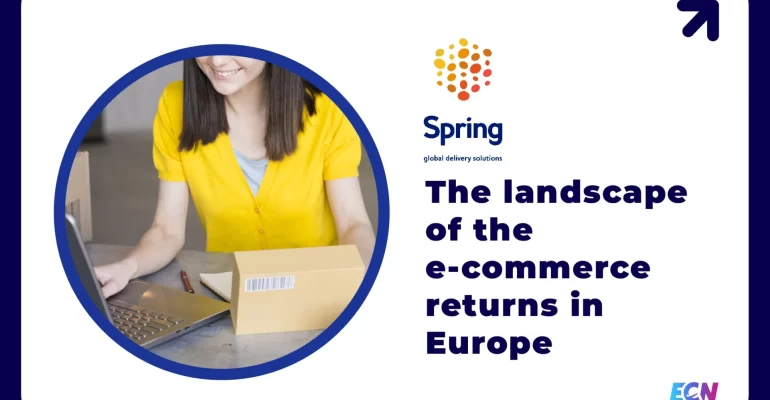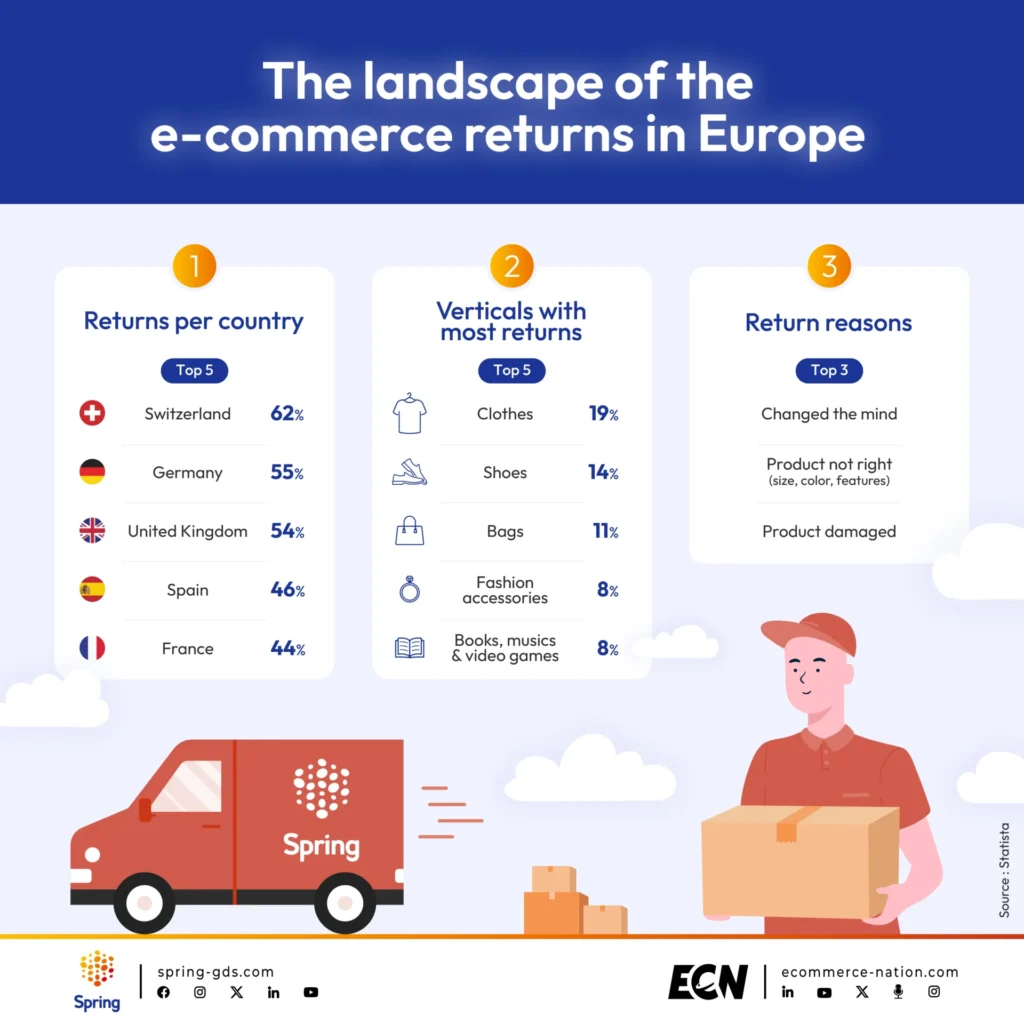E-commerce Returns in the European Market

E-commerce Returns in the European Market
Returns in the e-commerce market constitute a significant aspect that all e-commerce merchants need to consider. Indeed, the online sales process doesn’t end with the payment of the shopping cart; rather, returns are an integral part of the purchasing process.
In Europe, returns are evidently present, but their characteristics vary depending on the markets where e-commerce merchants operate and sell.
This article offers an overview of returns in the European e-commerce market, its challenges, and our recommendations for optimizing their management.
Overview of e-commerce returns in Europe
As mentioned earlier, e-commerce returns have become an integral component of the European commercial landscape, with significant implications for businesses and consumers.
This first part of our article will provide you with an overview of returns in European markets, highlighting relevant statistics, their impact on profitability and customer satisfaction, as well as the sectors affected and current trends in consumer behaviour.
Statistics of returns in European markets
According to the latest data, the average return rate in Europe ranges between 30% and 40% of online purchases, with significant variations from one country to another and from one sector to another.
For instance, according to a Statista study, in 2023, Switzerland had the highest return rate per online buyer in Europe at 62%. Germany closely follows with 55%, and the United Kingdom completes this podium with 54% of returned products.

E-commerce returns have a considerable impact on businesses’ profitability and customer satisfaction. For that matter, brands have started charging for returns because of its cost and, in some cases, abusive nature of the returns requested.
From a profitability standpoint, returns represent a significant cost for retailers, including return processing fees, restocking costs, and revenue losses associated with reselling returned products at reduced prices.
Regarding customer satisfaction, efficient returns management can play a crucial role in customer retention by strengthening their trust in the online purchasing process and providing positive experiences even in case of issues with a product.
Affected business sectors
E-commerce returns affect many business sectors, although some are more likely to be affected. For example, the fashion and apparel industries often experience higher return rates due to the subjective nature of style and size preferences.
According to Statista, in the past 12 months:
- 19% of returns were related to clothing purchases;
- 14% were related to shoes;
- 11% were related to bags and accessories.
Similarly, electronic products, accounting for 6% of returns, and household items, also at 6%, can also generate a significant number of returns due to compatibility issues, manufacturing defects, or simply changes in consumer preferences.
Why are goods returned?
Understanding why consumers return products is essential for e-commerce merchants seeking to reduce return rates and improve the customer experience.
Current consumer behaviour trends reveal several common reasons for returns, including:
- Returns resulting from simple changes of opinion or preferences;
- Discrepancies between the received item and the one ordered;
- Damaged or defective products;
- Order errors.
Following this overview of e-commerce returns in the European market, let’s now focus on the challenges surrounding these returns.
A new trend is Bracketing. Check out what it is about and how to avoid this in your online shop.
2 – Challenges about e-commerce returns in Europe
We have just seen that returns are an integral part to the e-commerce process. Now, the goal for any online seller is to address the challenges posed by these returns.
Logistical challenges of returns
Returned product flows require robust logistical infrastructure to be processed efficiently, which can be complex due to the diversity of return destinations, processing times, and parcel traceability requirements.
Logistical challenges are particularly pronounced in the case of cross-border returns, where businesses must contend with customs regulations and additional shipping costs.
Cross-border regulations
Differences in laws and business practices between European Union member countries can complicate the management of cross-border returns, especially regarding refunds, exchanges, and consumer rights.
Companies must navigate this complex regulatory landscape carefully to avoid legal disputes and negative consequences for their reputation.
Examples of imports and exports cross-borders rules:
- The United Kingdom has established new import and export rules post-Brexit, including specific declaration and documentation requirements for trade with the EU and other countries;
- The United States has strict rules regarding the import of certain products, as well as restrictions on the export of sensitive goods. Companies must comply with regulations from the Department of Commerce and other government agencies;
- The EU has import and export rules for trade with third countries, governed by trade agreements and specific regulations. Companies must comply with EU requirements for border control and customs declaration;
- China has strict import and export rules for many products, with specific requirements for cross-border trade. Companies must comply with regulations from the General Administration of Customs of China (GACC) and other government agencies.
Financial challenge
Another crucial consideration is the financial challenge, with significant costs associated with return processing, product reallocation, and revenue losses. E-commerce merchants must balance between customer satisfaction and profitability by implementing effective return policies while minimizing associated costs.
Ecological challenges
In addition to logistical and financial challenges, e-commerce returns also have a significant environmental impact in Europe and worldwide. Traditional return processes lead to increased carbon emissions due to the additional transport of returned products, as well as increased production of packaging waste, such as plastic or bubble wrap.
For example, labelling and packaging standards for cross-border trade can vary depending on national regulations and requirements of importing countries. Here are some examples:
- The United Kingdom has labeling and packaging requirements for imported and exported products, governed by agencies such as the Food Standards Agency (FSA) and the Trading Standards Authority (CTA);
- The United States has strict regulations on labeling of imported products, governed by agencies such as the Food and Drug Administration (FDA) and the United States Department of Agriculture (USDA);
- The EU has harmonized labeling and packaging standards for cross-border trade among member countries, regulated by regulations such as the Regulation on Consumer Information (EU FIC);
- China has labeling and packaging requirements for imported products, governed by agencies such as the General Administration of Quality Supervision, Inspection and Quarantine (AQSIQ) and the National Medical Products Administration (NMPA).
Moreover, the disposal of returned products can contribute to environmental pollution if these products are simply discarded rather than being resold second hand or recycled.
Managing customer expectations and satisfaction
Consumers expect simple, fast, and hassle-free return processes. Most of the time, consumers are interested in how much returning an item will cost them, even before placing an order. Moreover, brands must think about local return addresses in order to lower the return cost for their customers.
Companies must invest in robust systems and policies to meet these expectations. Delays in return processing, restrictive or unclear return policies, and high return fees can lead to customer dissatisfaction and damage the company’s reputation.
Moreover, effective returns management can enhance customer trust in the brand and improve their shopping experience, while poor management can lead to increased frustration and mistrust.
Delays in returns means that a consumer has to wait longer in order to receive a reimbursement, which can cause dissatisfaction with the brand. Or having limited options on how to process a return, like they don’t have a return point close, can also negatively impact their experience with the ecommerce.
In this way, companies must recognize the importance of customer satisfaction in returns management and invest in solutions that meet the needs and expectations of consumers.
3 – How to optimize returns for e-commerce sellers?
Faced with the challenges posed by returns, e-commerce merchants must seek solutions to optimize returns management. Here are some strategies to consider:
Provide a user-friendly return policy
E-commerce sites should implement clear and transparent return policies that facilitate the return process for customers, offering options such as prepaid return labels, extended return deadlines, and prompt refunds.
A user-friendly return policy can improve customer satisfaction and reduce returns by encouraging customers to trust the quality of the products.
Use technological solutions for efficient return processing
Technological advances offer solutions to improve the efficiency of return processing. E-commerce sellers can invest in technology-based return management logistics solutions to automate and streamline return processing processes, thereby reducing costs and processing times.
These solutions may include online return management platforms, real-time parcel tracking tools, and inventory management systems to facilitate reallocation of returned products.
Analyze data to understand returns
Data analysis plays a crucial role in optimizing returns for e-commerce sellers. By collecting and analyzing data on returns related to their e-commerce activities, companies can identify trends and return patterns, allowing them to make informed decisions to reduce future returns.
For example, an online clothing retailer might analyze return data to identify common reasons for returns, such as size discrepancies or dissatisfaction with fabric quality. Armed with this information, they can take proactive steps such as providing detailed size charts or enhancing product descriptions to reduce returns.
Similarly, a consumer electronics company could utilize data analysis to identify product performance issues leading to returns, enabling them to refine their quality control princesses or provide better customer support to address these issues promptly.
Data can also be used to personalize offers and recommendations to customers, thus improving the shopping experience and reducing returns related to product satisfaction.
Opt for an ecological strategy
An environmentally friendly return may include educating customers about the environmental impact of returns and encouraging them to reuse packaging. For instance, an e-commerce company could provide information on the carbon footprint of returns and promote initiatives like using recycled packaging materials.
Additionally, designing eco-friendly product packaging can significantly reduce waste. For example, companies might opt for biodegradable or compostable packaging materials rather than traditional plastics. By using easily recyclable or biodegradable materials, businesses can minimize the environmental impact of their packaging.
Moreover, e-commerce merchants can adopt more sustainable return processing practices, such as batch shipping. By consolidating returned items into fewer shipments, companies can reduce the number of vehicles needed for transportation, thus minimizing carbon emissions associated with the transport of returned products. This approach benefits the environment and helps streamline logistics and reduce costs for the business.
Conclusion
With this overview of e-commerce returns in Europe, we can affirm that returns are unavoidable for online sellers who must strive to find a balance between customer satisfaction, profitability, and environmental sustainability.
By adopting user-friendly return policies, innovative technological solutions, and ecological strategies, companies can turn e-commerce returns into an opportunity for differentiation and growth in the European market while meeting the expectations of online shoppers.


